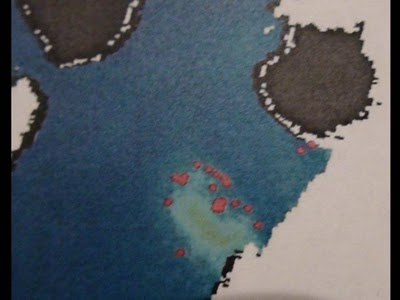Nice story the tale of the unexpected bloom but it was a joke. Sorry. December 28th is the day of "inocentes" and the tradition is to give some credible but false news. The icon of this day is the next one:

Happy new year for all of our followers.
 Phase I of the bloom south of Gran Canaria Island. Observe the formation of the phytoplankton outburst (in green) and the formation of cyanobacteria (red dots). Areas in white are clouds formed during the last weeks due to an important low crossing the islands from southwest to northeast.
Phase I of the bloom south of Gran Canaria Island. Observe the formation of the phytoplankton outburst (in green) and the formation of cyanobacteria (red dots). Areas in white are clouds formed during the last weeks due to an important low crossing the islands from southwest to northeast.  Phase II of the bloom. Observe the increase in phytoplankton (green) and the growth of cyanobacteria at the boundaries of the forming bloom (red). Areas in white are clouds.
Phase II of the bloom. Observe the increase in phytoplankton (green) and the growth of cyanobacteria at the boundaries of the forming bloom (red). Areas in white are clouds. Phase III of the bloom. The area of the phytoplankton bloom is approaching the size of Gran Canaria Island. The cyanobacteria remained at the edge of the bloom.
Phase III of the bloom. The area of the phytoplankton bloom is approaching the size of Gran Canaria Island. The cyanobacteria remained at the edge of the bloom.
 Phase IV. Observe the impressive size of the phytoplankton outburst and the generation of cyanobacteria at the boundaries of the bloom. Right now, our concern is the proximity of the bloom and cyanobacteria to the south of Gran Canaria during the last hours.
Phase IV. Observe the impressive size of the phytoplankton outburst and the generation of cyanobacteria at the boundaries of the bloom. Right now, our concern is the proximity of the bloom and cyanobacteria to the south of Gran Canaria during the last hours.

Gara Franchy and Inma Herrera preparing the dilution experiments
Gara filtering seawater from the 30 L Niskin bottles for the dilution experiments Inma Herrera working with the MOCNESS
Inma Herrera working with the MOCNESS Gara, Jaime and Inma
Gara, Jaime and Inma
 The cruise leader Dr. Jaime Färber-Lorda (orange shirt) and the cruise members.
The cruise leader Dr. Jaime Färber-Lorda (orange shirt) and the cruise members.
 Peaceful inhabitants of Antarctica
Peaceful inhabitants of Antarctica